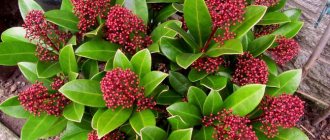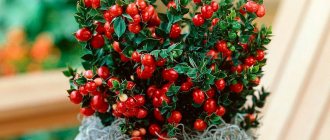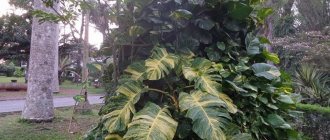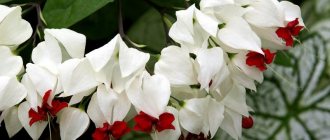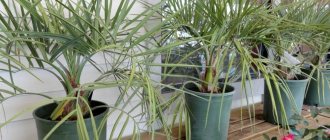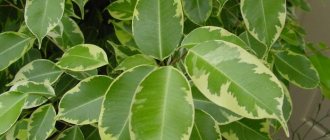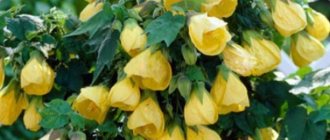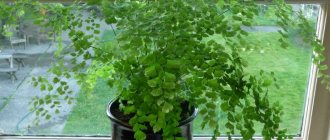Features of Pilea
Pilea is a hardy plant, reaching a height of 0.4 m and having decorative foliage. This plant is most often grown in winter gardens, warm flower beds and display cases. Pilea Cadieu differs from other species in its very rapid growth, which is of particular value for gardeners who use it when arranging compositions of various flowers. Small unisexual flowers are most often collected in axillary racemes. The plant distributes its fruits in an extremely unusual way, which is similar in its mechanism to ejection. By the time of fruiting, the sterile stamens (staminodes) grow greatly and only slightly support the fruit hanging over them. In a ripe fruit, the connection with the plant is greatly weakened. At this time, the sterile stamens straighten and throw the fruit up to a distance of one hundred meters.
Botanical description of the plant
Pilea is classified as a member of the nettle family. This is a small compact plant with unusually beautiful foliage. Represented by perennials, annuals and shrubs.
Common in areas with tropical climates.
The main characteristics of the Pilea are collected in the table:
| Root system | superficial |
| Stem | 30–40 cm high |
| Leaf Shape | round, oval, lanceolate, solid or serrated |
| Leaf color | variegated (depending on type) |
| Inflorescence shape | axillary raceme with small flowers |
| Flower color | plain |
Did you know? From Latin the name of the flower Pilea is translated as cap. Pilea received this name due to the fact that one of the perianth leaves is shaped like a cap.
Brief description of cultivation
- Bloom . It is observed in June–October, but the flowers do not have high decorative value. At home, Pilea is grown as an ornamental foliage plant.
- Illumination . A large amount of bright diffused light is needed. Do not expose the flower to direct sunlight.
- Temperature regime . Throughout the year, the air temperature in the room should be about 25 degrees. But there are species that are more comfortable in winter at temperatures of about 10 degrees. However, most species may suffer when temperatures drop to 17 degrees or below.
- Watering . In the spring-summer period, the flower needs to be provided with such a watering regime so that the soil mixture in the pot is slightly moist (not wet) all the time. In winter, watering is carried out only when the substrate is 1/5 dry in depth.
- Air humidity . It should be elevated. Experts advise placing open vessels filled with water next to the flower, or you can pour wet pebbles into the tray. The foliage should not be moistened.
- Fertilizer . In the spring-summer period, fertilizing is carried out once every 7 days and for this purpose mineral complex fertilizers for decorative and deciduous plants are used. In winter, the amount of fertilizing is reduced to once every 4 weeks.
- Rest period . Observed in October–February.
- Transplant . The flower is replanted every year at the beginning of the growing season.
- Soil mixture . It should be humic, slightly acidic or neutral. Its composition should include sand, peat, humus and turf soil in equal parts.
- Reproduction . By cuttings and seeds.
- Harmful insects . Mealybugs, thrips, spider mites and scale insects.
- Diseases . Problems with Pilea foliage can only arise if it is not properly cared for.
Pilea Cadieux - home care. [Hope and Peace]
Main types
Over 400 species of Pilea are known to exist.
The following are most often grown at home:
- Cadieux . The flower does not exceed 40 cm in height. It has elongated oval-shaped leaves with 2 broken silver lines.
- Small-leaved . A compact ground cover species up to 15 cm high with miniature round, coin-like leaves.
- Thickleaf . The most popular type. Attracts attention with its embossed velvety green and red leaves.
- Wrapped . It grows up to 30 cm in height. Its leaves are rough, green with a bronze tint and dark brown veins.
- Peperomyoid . Miniature appearance with tiny green glossy coin-shaped leaves.
- Lebanese . A small plant with drooping shoots and rounded silvery leaves.
Pilea care at home
Illumination
Pilea needs bright but diffused light. Direct rays of the sun should not fall on the bush. A western or eastern window sill is best suited for growing such a flower. If you decide to place it on a south window, then be sure to provide it with diffused light, or you can move it deeper into the room. In the summer, the plant can be moved outside, but you need to choose a place for it that will be reliably protected from direct sunlight. Remember that in the cold season, Pilea also needs a lot of light, but if there is too little of it, the color of the foliage of the bush may change, which will negatively affect its decorative effect.
Temperature
The flower grows best throughout the year at a temperature of about 25 degrees. In winter, Pilea Kadiera grows well at temperatures up to 15 degrees, and Pilea peperomyoid - at 10 degrees. If you grow other species, then remember that the room where the bush is located should not be colder than 17 degrees. In winter, a draft can cause the death of a plant.
Watering
In the spring and summer, the substrate is moistened immediately after its top layer dries. To do this, you need to use well-settled water. In the cold season, watering is carried out two days after the top layer of the soil mixture has dried. Pilea is one of those plants that can much more easily tolerate drying out of an earthen clod than stagnant liquid in the substrate. Make sure that the substrate in the container is always slightly damp. With excessively abundant watering, the foliage may fade and wither, especially in the cold season.
Spraying
Indoor Pilea needs high air humidity, so you will have to monitor the humidity level in the room. It is highly undesirable to moisten foliage with a spray bottle, as this may cause it to lose its decorative effect. To increase humidity, the flower pot should be placed on a tray filled with moistened pebbles or expanded clay. However, make sure that the bottom of the container does not come into contact with the liquid. Instead, you can place an open vessel filled with water near the flower.
Fertilizer
In the spring-summer period, flower feeding is carried out regularly once every 7 days, and in autumn and winter - once every 4 weeks. To do this, use a complex mineral for indoor flowers; the concentration of the nutrient mixture should be as recommended by the manufacturer.
Trimming
When grown indoors, Pilea grows quite quickly. Since young bushes are much more spectacular than old ones, pruning should be done annually, and the cut stems should be used as cuttings. To increase the splendor of the bush and to avoid its exposure, you should systematically pinch the stems.
Pilea transplant
Household Pilea needs to be replanted every year. To do this, use humus soil with a slightly acidic or neutral reaction. So, you can take a soil mixture consisting of humus and turf soil, as well as sand and peat (they are taken in equal parts). Since the flower has a superficial root system, you need to use a small pot for replanting. In order to avoid stagnation of liquid in the substrate, it is necessary to make a good drainage layer at the bottom of the container. If desired, Pilea can be grown hydroponically.
Pilea. Transfer.
Reproduction methods
Pilea can be propagated by cuttings and seeds. Some species of this plant reproduce independently by seeds. If you decide to propagate it by cuttings, then this can be done at any time of the year. For rooting, the cuttings are placed in a container with water or planted in sand (loose substrate). After rooting, the cuttings are planted in a small pot filled with a soil mixture consisting of greenhouse and deciduous soil, as well as sand (1:1:1).
Plant transplantation and propagation
Pilea transplantation should be done annually in spring or summer. These plants do not need deep containers, since their root system is quite compact. Pots about 10 centimeters deep are ideal. Due to the fact that Pilea is a plant with random growth, young shoots should be plucked during replanting, and the oldest ones should be cut off. It is quite possible to grow a new flower from cut shoots. Propagation occurs both by cuttings and seeds.
The peculiarity of Pilea Monetolifolia is propagation by self-sowing from seeds formed on the plant itself.
For purchased seeds to germinate, it is necessary to provide them with light and warmth. They should be sown in a flat container with soil consisting of sand and earth. The container should be covered with glass, which should be removed when the first shoots appear. As soon as three or four true leaves are formed, each sprout must be planted in a small pot.
The fastest and most affordable method of propagation is cuttings. For this, blanks 10 cm long are used, which are cut from young apical shoots and placed in moistened sand or soil. For better rooting, it is necessary to create a microclimate by covering the plant with transparent material made of plastic or glass. When propagating Pilea coinifolia by cuttings, to obtain a more lush bush, several cuttings can be planted in a container at once.
This species can also be germinated from a leaf. The lower leaves, cut at the very base of the main stems, are best suited for this. Rooting should be done in the same way as for cuttings.
It should be noted that only some species can produce seeds for self-sowing propagation.
Possible problems
If the Pilea is not properly cared for, then problems may begin with it:
- The foliage dries up and flies away . If the room is colder than 12 degrees or warmer than 27 degrees, then the leaf plates will wrinkle, dry out, and fly around. This can also happen due to drying out of the earthen coma.
- The leaves are withering . If liquid regularly stagnates in the substrate, this can cause limp foliage to appear; after a while it will turn black and fly off, and the shoots will become soft.
- The leaves are turning pale . Excessively intense lighting can cause foliage to become faded, limp and a little translucent. At the same time, its edge dries and turns brown. Due to excessively poor lighting, the edges of the leaf blades will also turn brown and dry out, while they themselves lose their spectacular color, and young leaves grow small, the stems become elongated.
- Spots on leaves . As a result of exposure of the bush to direct rays of the sun, sunburn may form on the foliage, looking like yellow spots, which eventually turn brown.
- Flying leaves . If only the lower leaf plates fly around, then this is quite normal and is associated with the aging of the plant. In this case, it is recommended to cut several cuttings from the bush and grow a young plant from them.
- Harmful insects . Thrips, mealybugs, spider mites and scale insects can settle on the pilea.
Diseases and pests: table
| Symptoms | Cause | Solution |
| The plant is entangled in a thin web, the leaves wither and fall off. | Spider mite. Favorable conditions for its spread are dry environments. | Wipe the flower with soapy water, wash in a warm shower, and treat with attelik. |
| The foliage dries out and begins to fall off. It is very difficult to return the plant to its previous appearance. | Shchitovka | Treat the sawdust with Attelik or Fitoverm. |
| The outer surface of the leaves is covered with a large number of light-colored dots | Thrips | The means are the same as in the previous case. |
| The plant is covered with a white coating similar to flour. A sticky translucent coating (honeydew) appears on the tissues of the pilea, and the flower becomes sluggish. | Mealybug | The plant must be washed with soapy water, then treated with insecticides (actara, fitoverm). |
Note! The main difficulty is that it is quite difficult to detect pests on the variegated surface of multi-colored leaves.
Types of Pilea with photos and names
Pilea cadierei
This species is native to the tropical forests of Southeast Asia. The height of such a herbaceous perennial can be about 0.4 m. Young shoots are erect, but with age they become lodging. The bare and succulent stems are highly branched. Spectacular petiolate elongated oval leaf plates are pointed towards the top and have three veins. The leaves are about 20 centimeters long and 5 centimeters wide. The British call this species “aluminum plant”, and the Germans call it “silver pilea”. This is due to the fact that on the surface of the rich green or bluish-green foliage there are a pair of broken lines of silver color. During flowering, axillary racemes appear, consisting of small flowers. Young slender shoots begin to curl over time, resulting in an ampelous appearance. In order for the bush to be more lush, it will need systematic pinching.
Pilea microphylla
The height of such a herbaceous perennial is about 15 centimeters. The branching stems have lush foliage; if they come into contact with the surface of the soil, they quickly take root. The branches are similar in appearance to the fronds of a fern, they bend beautifully and have a large number of small bare greenish oval and round leaves, their length does not exceed 5 mm. Corymbose inflorescences are formed in the leaf axils and contain heterosexual and bisexual small flowers. Such a plant is popularly called “Artillery” or “Cannonier”; the fact is that the staminate flowers form a dusty cloud during the opening of the anthers. If you touch a Pilea parvifolia flower in the summer, it will release a haze of pollen.
Pilea nummulariifolia
This herbaceous perennial has stems that creep along the surface of the soil, reaching a length of about 0.4 m. Greenish round leaf plates grow on them. Over time, the bush grows and forms a carpet on the soil surface.
Pilea involucrata
The plant is a low bush, the height of which does not exceed 0.3 m. The shoots are erect. Opposite oval leaf plates have a point at the apex and reach a length of about 70 mm. The greenish leaves along the veins are lumpy brown. This species is widely used for hybridization.
Pilea peperomioides
The flower has a rigid stem and rounded leaf blades.
Pilea repens
The height of the bush, which has creeping shoots, is about 25 centimeters. Opposite smooth rounded leaf plates reach up to 25 mm in length and have a wavy edge. The front surface of the plates is dark green with a copper tint, and the back surface is purple.
Pilea spruceana
This plant comes from Peru and Venezuela. Short-petioled, oppositely located leaf plates of an ovoid or round shape, rotated 180 degrees, can be blunt or pointed at the apex. Foliage color is various shades of bronze or silver.
Pilea "Bronze"
The height of erect shoots is about 0.3 meters. Opposite oval leaf plates are pointed at the apex and have a length of up to 70 mm. They are silvery, wrinkled, and dark green along the veins. The plate may also have a silver stripe running along the central vein, with a dark green edge.
Pilea "Norfolk"
Scientists still have not figured out exactly how this form appeared. This herbaceous perennial has young stems that are erect, while mature stems are lodging. On the surface of the rich green wrinkled velvety leaf plates there are small bristly hairs. The veins of the foliage are brownish-red.
Pilea "Silver Tree"
The origin of this hybrid also remains a mystery. It is a spectacular, actively climbing, perennial sawweed. The oval, bronze-green foliage has a jagged edge and pubescence consisting of white or red hairs. A silver stripe runs down the center of the plate, and on its surface there are many spots of the same shade.
Pilea peperomiiformes Money tree from Asia, care and watering.

